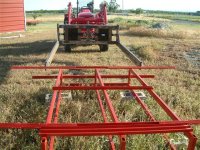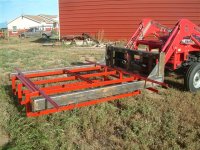Hi Guys, I'm the Dummy in this post, and I need educating by the experts and seasoned farmers out there.
This is my first year on the farm doing my own hay.
Im trying to collect as much info/knowledge as I can before the harvest season arrives.
I have some older New Holland equipment - late 70's/early 80's - 9ft NH hay bine, a late 50's NH Rake (real nice shape) and a late 70's/early 80's Sm Square NH Baler.
Tractor is a 2008 52 hp 4wd Montana c5264, 80 hrs on it
I know the basics (the real basics), cut one day, rake the next, bale the day after that. Dont let the hay get wet after its cut. Keep the machinery well oiled and Greased (alot)
I plan to mow a row or two (or maybe one lap around the field), Rake and Bale that first, just to get used to it. I dont think mowing all 75 acres at once would be wise for a newbie.
I have no clue on anything else, here are but a few of my unknowns:
-how high the cuting bar of the mower should be off the ground
-how high the Rake tines should be off the ground
-the PTO RMP speed to run the Mower at
-the PTO rpm to run the Baler at
-what speed/gear to run my tractor at while, mowing, raking, baling -- is slower better? e.g. i tend to use Low gear when working but not sure if 2nd or 3rd gear low is too slow (or good since it doesnt over stretch my 52 hp tractor)
-Baling is the part that worries me most -- seems like that twine has a lot of places to be routed and get bunged up.
-how do i test for moisture content, doe everyone have one of those testers?
-should i search for a farmer to assist me on Day 1 (I wonder if any of them would really have the time to do this) ?
-what oil to use on the chains
-what oil/greas to use on the knotters
-what grease to use on the wobble box etc
-i heard of a trick when joining the sp0ols of baler twine to keep the knots real tight (moistened by spit), and cut off the excess so it doesnt get caught up...what other tricks are there?
-what directiuon to i mow, rake, bale ? do I do laps, or side by side row's ?
-If i rake the 1st row will it land on the second row?
- do i rake in only 1 direction to avoid lumping 2 rows of hay together?
and, to be honest, I dont know what I dont know.
I've looked forward to this for a while now, but....now its almost here Im darn' terrified of getting it all wrong.
what would those of you that have done this for years teach me?
what would those of you that have done this once or twice tell me you wish you'd have known in advance ?
Thanks in advance
Baler speed--walking speed, but you need to have the windrows set up to feed the baler pickup effectively--not too much, not too little. This part takes some trial and error to get it right. If your crop is thin, you may have to combine windrows to get enough hay moving through the baler to make tight bales.
Baler chains-I used 20W motor oil and a sponge to oil the chains. The chain that drives the pickup is a little hard to reach so I tape the sponge to a 3-ft piece of steel conduit to reach the chain.
Baler gear box--80W gear oil
Knotters-I spray with WD-40 every few weeks when the baler is in the equipment shed to prevent rust. Grease the knotter at the zerks, but no oil on the outside of the knotter--just WD-40
PTO speed--my MF124 is designed for 540 rpm and 80 strokes per minute. You need to keep rpms up so the baler packs the hay firmly in the bale chamber.
Cutting bar--I leave about 4" stubble height. The mowed hay dries better laying on tall stubble, or so I'm told.
Bale wedges--my baler can accommodate 3 pairs of wedges. It came with only one pair. So I welded up two additional pairs using steel angle and bar stock. You add wedges to the sides of the bale chamber to compensate for a hay crop that's producing loose bales. Again, it's a matter of trial and error to figure out if you need the wedges and then how many to install.
Slip clutch--check out the SC on your baler--the SC on mine was worn out. I had to order new clutch discs. My SC has a built-in sprag clutch that has to be greased.
Needles--my MF124 is a two-twine baler and one of the needles was banging into the twine disc. So I had to realign that needle (two bolts for adjustment and 5 minutes of labor). Needle alignment is fairly critical to get the knotter to work properly.
You also need to check the alignment and operation of the plunger stop that keeps the needles from being damaged by the plunger if the knotter chain breaks. The plunger stop operates off the needle swing bar.
I hope you have operating, service and parts manuals for all your haying equipment--otherwise you're flying blind.
If I think of anything else, I'll post back.


